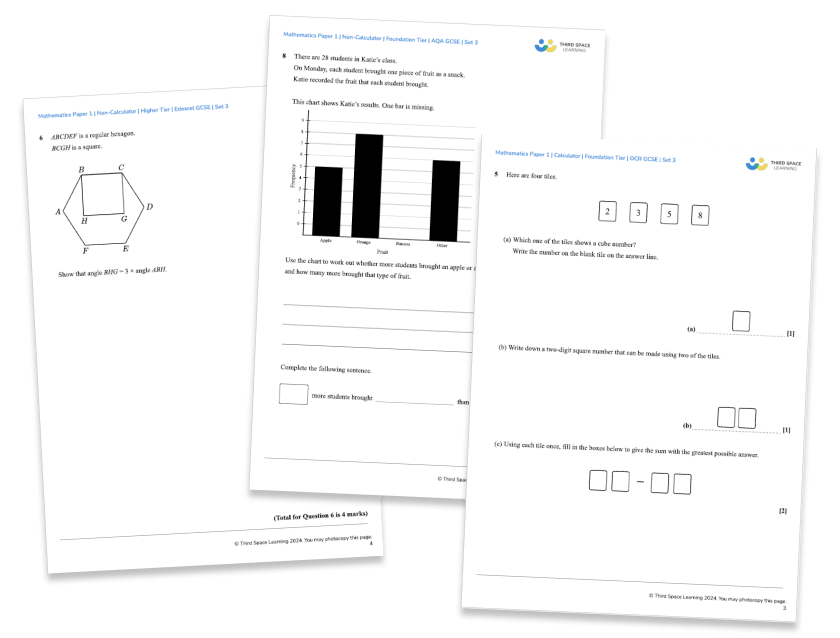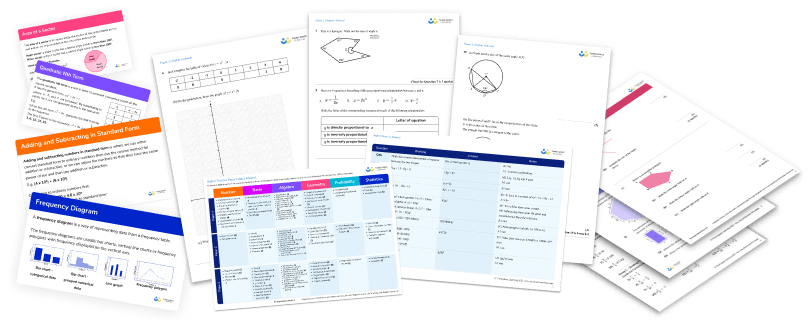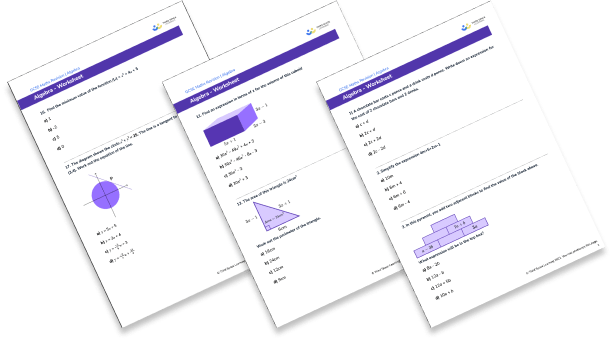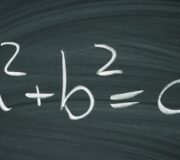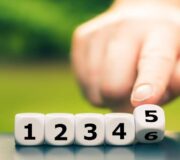15 Algebra Questions And Practice Problems (KS3 & KS4): Harder GCSE Exam Style Questions Included
Algebra questions involve using letters or symbols to represent unknown values or values that can change. Here you will find 15 algebra questions to test your knowledge and show you the different ways that algebra can be used to solve a problem to find an unknown value or to make generalisations.
Algebra in KS3 and KS4
There are many topics and techniques within algebra. In KS3 we learn to write and manipulate basic algebraic expressions and linear equations. In KS4 we develop these techniques to allow us to deal with more complicated algebra problems such as ones that involve quadratic equations or a system of equations.
GCSE MATHS 2026: STAY UP TO DATE
Join our email list to stay up to date with the latest news, revision lists and resources for GCSE maths 2026. We’re analysing each paper during the course of the 2026 GCSEs in order to identify the key topic areas to focus on for your revision.
GCSE dates 2026
GCSE results (2026 when available)
Get ahead on revision with the GCSE maths papers analysis from 2025:
Analysis of GCSE Maths Paper 1 2025
Analysis of GCSE Maths Paper 2 2025
GCSE Maths Paper Analysis and Summary 2025
GCSE Maths Teacher Survey Results 2025
How to solve algebraic questions
When you are presented with an algebraic problem it is important to establish what you are being asked to do. Here are some of the key terms along with what they mean:
- Solve the equation – find out the value of the unknown
- Substitute – put the values you have been given into the algebraic expression
- Simplify – collect together like terms to make the expression or equation look simpler
- Expand brackets – multiply out the brackets
- Factorise – put into brackets
- Make x the subject – rewrite the equation in the form x =…..
Remember, when working with algebra, we must still apply BODMAS / BIDMAS. i.e. Brackets, Indices (powers, exponents, square roots), Division, Multiplication, Addition, Subtraction.
When working with algebraic expressions and equations we must consider carefully which operations to deal with first.
Download this 15 Algebra Questions And Practice Problems (KS3 & KS4) Worksheet
Help your students prepare for their Maths GCSE with this free Algebra worksheet of 15 multiple choice questions and answers.
Download Free Now!Algebra in KS2
The ideas of writing and simplifying expressions, solving equations and substitution are introduced in KS2. Here are some example KS2 algebra questions:
Algebra questions KS2
1. A chocolate bar costs c pence and a drink costs d pence. Write down an expression for the cost of 2 chocolate bars and 2 drinks.




2 chocolate bars would cost 2 lots of c, or 2c, and 2 drinks would cost 2 lots of d, or 2d.
2. Simplify the expression 4m+5+2m-1




We need to collect together like terms here so 4m + 2m = 6m and 5 – 1 = 4 (watch out for the negative).
Algebra questions KS3
In KS3 we learn a variety of different algebra techniques to answer algebra questions and to practise problem solving with algebra. These include:
- Simplifying algebraic expressions
- Expanding brackets and factoring
- Forming algebraic equations from word problems
- Solving algebraic equations and inequalities
- Substituting into expressions
- Changing the subject of an equation
- Working with real life graphs and straight line graphs
- Sequences
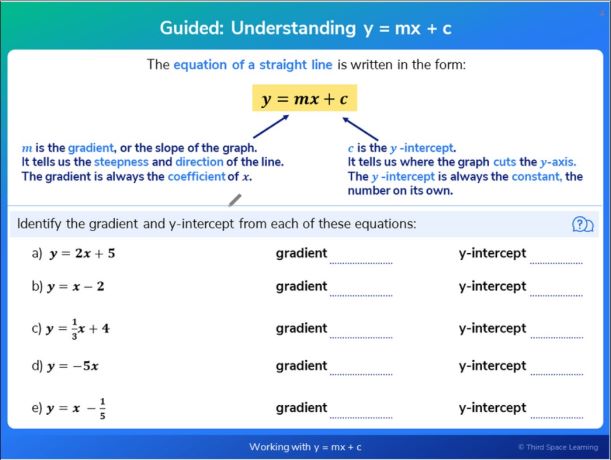
You may also like:
Algebra questions KS3: basic algebra
1. In this pyramid, you add two adjacent blocks to find the value of the block above.
What expression will be in the top box?




2. Brian is a window cleaner. He uses the following formula to calculate the amount to charge his customers:
Charge = £20 + 4n
Where n is the number of windows a house has.
If a house has 7 windows, how much would Brian charge?




In this question, n is 7 so we can substitute 7 into the formula.
Charge = £20 + 4 × 7
Charge = £48
3. The area of a rectangle is 4x-6.
Which of the following pairs could be the length and width of the rectangle?
4x and 6x

4 and x-6

2 and 2x-3

2x and 2x-3

There are two ways of attempting this question. We know that area \;of \;a \;rectangle = length × width so we could multiply each pair together to see which pair makes 4x − 6.
\begin{aligned} &4x × 6x \quad \quad\quad\; \;24x^2 \\ &4 × (x − 6) \quad \quad \quad4x − 24\\ &2 × (2x − 3) \quad \quad \;\;4x − 6\\ &2x × (2x − 3) \quad \quad 4x^2 − 6x\\ \end{aligned}
Alternatively, if we factorise 4x − 6 we get 2(2x − 3) meaning the sides could be 2 and 2x − 3.
4. The formula for changing degrees Celsius to degrees Fahrenheit is
F=\frac{9C}{5}+32
Rearrange this formula to make C the subject.




Algebra questions KS3: forming and solving equations
5. Work out the size of the smallest angle.




The angles in a triangle add up to 180^{\circ} therefore we can write
4x+2x-10+3x-8=180
Now we have an equation we can solve.
\begin{aligned} 9x-18&=180 \hspace{3cm} &\text{add } 18\\ 9x&=198 &\text{divide by } 9\\ x&=22^{\circ} \end{aligned}
The angles are :
\begin{aligned} 4\times22&=88^{\circ}\\ 2\times22 -10&=34^{\circ}\\ 3\times22 -8&=58^{\circ} \end{aligned}
The smallest angle is 34^{\circ} .
6. Jamie’s dad is 4 times older than Jamie. In 14 years time, Jamie’s dad will be twice the age of Jamie.
What is the sum of Jamie’s age now and Jamie’s dad’s age now?




To solve this we need to write an equation.
Let Jamie’s age now be x . Then Jamie’s dad’s age is 4x .
In 14 years time Jamie’s age will be x + 14 and Jamie’s dad’s age will be 4x + 14 .
Since we know Jamie’s dad’s age will be two times Jamie’s age, we can write
4x+14=2(x+14)
Now we have an equation we can solve.
\begin{aligned} 4x+14&=2(x+14) \hspace{3cm} &\text{expand the brackets}\\ 4x+14&=2x+28 \hspace{3cm} &\text{subtract 2x}\\ 2x+14&=28 \hspace{3cm} &\text{subtract 14}\\ 2x&=14 \hspace{3cm} &\text{expand the brackets}\\ x&=7 \hspace{3cm} \end{aligned}
Jamie is currently 7 years old meaning his dad is 28 years old. The sum of their ages is 35 .
Algebra questions KS3: graphs
7. Which of the following lines passes through the point (2, 5)?




At the point (2, 5), x is 2 and y is 5. We can check which equation works when we substitute in these values:
\begin{aligned} y&=2x−1 \quad \quad \quad 5=2×2−1 \quad \quad \text{False}\\ y&=2x+1 \quad \quad 5=2×2+1 \quad \quad \text{True}\\ y&=4x−2 \quad \quad \quad 5=4×2−2 \quad \quad \text{False}\\ y&=2x+5 \quad \quad 5=2×2+5 \quad \quad \text{False} \end{aligned}
Algebra questions KS4
Algebra is studied extensively in the GCSE and IGCSE curriculum.
In KS4 we build on the techniques learnt in KS3. Topics include:
- Expanding and factorising polynomials
- Solving quadratic equations
- Solving simultaneous equations
- Inequalities
- Algebraic fractions
- Further work on graphs
- Functions

Algebra questions KS4: algebraic manipulation
8. Which of the following expressions has the smallest value when a=5 and b=-3?




9. Find an expression in terms of x for the volume of this cuboid




Volume = (5x+1)(2x-3)(3x-1)
Volume = (10x^2+2x-15x-3)(3x-1)
Volume = (10x^2-13x-3)(3x-1)
Volume = 30x^3-39x^2-9x-10x^2+13x+3
Volume = 30x^3-49x^2+4x+3
Algebra questions KS4: forming and solving equations
10. The area of this triangle is 24cm^2 .
Work out the perimeter of the triangle.




The area of a triangle is area = \frac{1}{2} × b × h.
If we fill in what we know we get:
\begin{aligned} 24&=\frac{1}{2}\times 6 \times (3x-1) \hspace{3cm} &\text{simplify}\\\\ 24&=3(3x-1) &\text{multiply out the brackets}\\\\ 24&=9x-3 &\text{add 3}\\\\ 27&=9x &\text{divide by 9}\\\\ x&=3 \end{aligned}
Since x = 3 , the side lengths are 6m, 8cm and 10cm .
The perimeter is 6 + 8 + 10 = 24cm .
11. Solve the equation x+2-\frac{15}{x}=0
x=-2 or x=15

x=-3 or x=5

x=-5 or x=3

x=-15 or x=2

We can make this a bit easier by getting rid of the fraction involving x. We do this by multiplying each term by x.
\begin{aligned} x+2-\frac{15}{x}&=0 \hspace{3cm} &\text{multiply by x}\\\\ x^{2}+2x-15&=0 &\text{factorise}\\\\ (x+5)(x-3)&=0 &\text{solve}\\\\ &x=-5 \text{ or } x=3 \end{aligned}
12. At a theme park the Jones family purchased 2 adult tickets and 3 child tickets for £48 . The Evans family purchased 3 adult tickets and 1 child ticket for £44 .
Calculate the cost of one child ticket.




We can write simultaneous equations to solve this.
2a+3c=48 (Equation 1)
3a+c=44 (Equation 2)
Multiply equation 2 by 3 to make the coefficients of c equal: 9a+3c=132 (Equation 3)
Subtract equation 1 from equation 3:
7a= 84
a=12
Substitute a into equation 3:
3×12+c=44
36+c=44
c=8
The cost of an adult ticket is £12 and a child ticket is £8 .
Algebra questions KS4: graphs
13. Which of these lines is parallel to the line 2y = x + 7




For two lines to be parallel, their gradient must be equal.
If we rearrange 2y=x+7 to make y the subject we get y=\frac{1}{2}x+\frac{7}{2}.
The gradient is \frac{1}{2}
14. Find the minimum value of the function f(x) = x^2+4x+5 .




To find the minimum value we need to complete the square.
\begin{aligned} f(x)&=x^2+4x+5\\ f(x)&=(x+2)^2-4+5\\ f(x)&=(x+2)^2+1 \end{aligned}
The minimum value is 1. This occurs when (x+2) is 0.
15. The diagram shows the circle x^2+y^2=25 . The line is a tangent to the circle at the point (3,4) . Work out the equation of the line.




To work out the gradient of the line we need to work out the gradient of the normal.
We know that the normal goes through the points (0, 0) and (3, 4) so we can calculate the gradient: \frac{4-0}{3-0}=\frac{4}{3}.
The gradient of the tangent will be \frac{-3}{4}.
We can now use y=mx+c . We know the tangent goes through the point (3, 4) and that it’s gradient is \frac{-3}{4} .
Therefore
\begin{aligned} 4&=\frac{-3}{4} \times 3 +c\\\\ 4&=\frac{-9}{4}+c\\\\ 4+\frac{9}{4}&=c\\\\ \frac{25}{4}&=c \end{aligned}
y=\frac{-3}{4}x+\frac{25}{4} \text{ or } 4y=-3x+25
DO YOU HAVE STUDENTS WHO NEED MORE SUPPORT IN MATHS?
Skye – our AI maths tutor built by teachers – gives students personalised one-to-one lessons that address learning gaps and build confidence.
Since 2013 we’ve taught over 2 million hours of maths lessons to more than 170,000 students to help them become fluent, able mathematicians.
Explore our AI maths tutoring or find out how our GCSE maths tutoring programmes could support students in your school.
